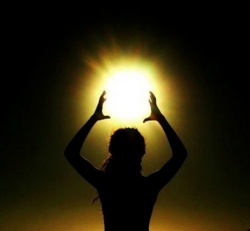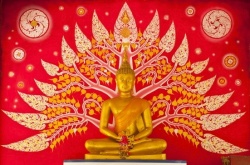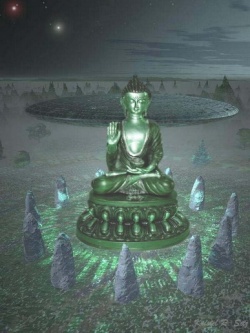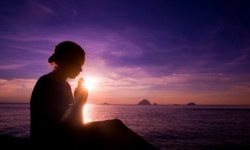Kunga Drolchog
Kunga Drolchog (kun dga' grol mchog) was born in 1507 (d.1566) in Lo Montang (glo smon thang), the capital of the Mustang (glo) region of present-day Nepal.
His main teacher as a youth was his uncle, the Sakya master Drungpa Choje Kunga Chogdrub (drung pa chos rje kun dga' mchog grub, d.u.), who was a disciple of the great Sakya master Dagchen Lodro Gyeltsen (bdag chen blo gros rgyal mtshan, 1444-1495).
Kunga Drolchog received ordination as a novice monk from Drungpa Choje when he was ten years old, and stayed with him constantly for the next four years, receiving many initiations and teachings of the Sakya tradition, including Lamdre three times.
In 1519, when Kunga Drolchog was thirteen years old, he traveled with his elder brother to U and Tsang for further studies.
They first went to the great monastery of Sakya and the nearby retreat center of Khau Dragdzong (kha'u brag rdzong), where they received teachings from the master Kunpang Doringpa (kun spangs rdo ring pa, d.u.).
Then they proceeded to the Sakya monastery of Serdogchen (gser mdog can), the monastic seat of Panchen Shakya Chogden (paN chen shAkya mchog ldan, 1428-1507), where they began the serious study of epistemology and other scholastic subjects under the guidance of Shakya Chogden's disciple and successor, Donyo Drubpa, known by the Sanskrit version of his name, Amoghasiddhi (a mo g+ha sidd+hi, don yod grub pa, d.u.).
But tragedy soon stuck. A smallpox epidemic claimed the lives of nineteen of the twenty-two students, including Kunga Drolchog's elder brother.
The grief-stricken Kunga Drolchog went into retreat for the next eight months.
During this time he memorized several basic treatises of epistemology.
But then his teacher Amoghasiddhi came into the retreat and severely scolded him, warning him that sterile scholarship did not result in enlightenment, and taught him many profound techniques of meditation practice.
When the smallpox epidemic had passed, Kunga Drolchog emerged from retreat to again receive many Lamdre teachings and other traditions from the master Kunpang Doringpa, who had come to visit Serdogchen Monastery.
He continued to study all the major and minor fields of knowledge for the next five years at Serdogchen and other monasteries such as Ngor and Ngamring (ngam ring).
Kunga Drolchog then returned home to Mustang, where he received full ordination and many more teachings from his old teacher Drungpa Choje and the ninth abbot of Ngor monastery, Lhachog Sengge (lha mchog seng ge, 1468-1535), who was visiting from Tibet.
Drungpa Choje installed Kunga Drolchog as his successor on the throne of Pupag (phu phag) Monastery and passed away soon after.
Then Kunga Drolchog's father also passed away.
The deaths of his teacher and his father affected him deeply, and with the realization that no composite phenomena are lasting, Kunga Drolchog went into seclusion and lived as a hermit.
He did not wish to attend the summer retreat of the monks that year, but at the insistence of the abbot he left seclusion and gave various teachings, such as the great Sakya Pandita Kunga Gyeltsen (sa skya paNDi ta kun dga' rgyal mtshan) Treasury of Epistemology (tshad ma rigs gter).
In 1528 another of [[Kunga Drolchog's] teachers in Mustang, Panchen Jampa Lingpa (paN chen byams pa gling pa, d. 1528), passed away.
Kunga Drolchog occupied the monastic seat at his teacher's monastery for the next three years, which was a period of further intense study and teaching.
On one occasion he went to visit the famous pilgrimage site of Muktinath in Nepal, where he spoke with and taught to the non-Buddhist Indian yogins using the Nepalese and Indian vernacular, to their great delight.
In 1534, when he was twenty-seven years old, Kunga Drolchog again traveled northeast into Tibet, visiting Lhasa and then the great Karma Kagyu monastery of Tsurpu (mtshur phu), where he received the complete transmission of the Kagyu teachings.
He would later travel several more times back and forth between Mustang and central Tibet.
Kunga Drolchog was especially devoted to the practices of the Shangpa Kagyu (shangs pa bka' brgyud) tradition, which he received from the master Gyagom Lekpa Gyeltsen (rgya sgom legs pa rgyal mtshan, d.u.) and other teachers.
He met the Dakini Niguma in a vision and taught the Shangpa transmission of the Six Dharmas of Niguma (ni gu chos drug, d.u.) more than one hundred times to many masters from different traditions.
He also frequently taught Lamdre and other precious instructions of the Sakya tradition throughout his career.
Kunga Drolchog was a master of the Jonang tradition's six-branch yoga of Kalacakra (dus 'khor sbyor drug), which he received from Lochen Ratnabhadra (lo chen ratna bha dra, 1489-1563), who seems to have been the most important of his many teachers.
For about the last twenty years of his life Kunga Drolchog was the twenty-fourth holder of the monastic seat of Jonang Monastery, retaining this position until his death in 1566.
He was succeeded on the Jonang throne by his nephew, Kunga Pelzang (kun dga' dpal bzang, 1513-1593).
Cyrus Stearns is a scholar based in Washington State, USA. He received his Ph.D. from the University of Washington in 1996. Published August 2008.
Bibliography:
Kun dga' grol mchog. 1992. The Autobiographies of Jo-nang Kun-dga' grol-mchog and His Previous Embodiments. New Delhi: Tibet House.
see also: Jetsun Kunga Drolchog




